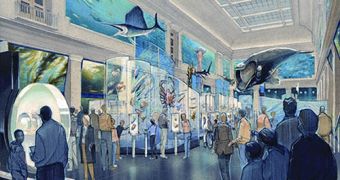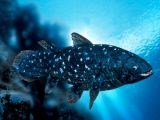In an attempt to address the downfall of the planetary ocean, as well as in order to provide a live learning place for scholars or for curious people, the Smithsonian museum will house the Sant Ocean Hall, a place where both living and fossil specimens from the depths of the oceans are exposed.
The deepest levels of Earth's oceans are perhaps less known than the outer space. There are more people who have walked on the surface of the moon than there are those who explored the vastness of oceans’ deepest riches. This is due to the fact that the latter represents a life-threatening barrier in the attempt of their exploration. The enormous pressure exerted on any body that would dare to sink this far instantly crushes anything. Such pressures range between 3.000 and 9.000 pounds per square inch (14.65 tons/square meter and 44 tons/square meter), 100 to 300 times higher than air pressure in car tires, while in the deepest point in the Mariana Trench – 35.802 ft (10.912 m) deep – it reaches as much as 8 tons per square inch (12.600 tons/square meter). This would be like an average woman trying to hold 48 jumbo jet planes over her head.
Besides pressure, temperature is another factor that keeps curious eyes far from the riches on the bottom of the ocean. Down there, water is close to freezing, at only 39 degrees Fahrenheit (4 degrees Celsius). Not to mention that, even if cold and crushing pressure weren't a problem, one couldn't see a thing in the dark. Even in the clearest of waters and at the time of the day when sun shines the brightest, sunlight gets dimmer every 250 feet (75 meters). This means that below 1.600 feet (500 meters), vision is seriously, if not totally, reduced, as light is only one millionth the intensity of that at the surface.
This is why the Smithsonian, in association with the National Oceanic and Atmospheric Administration (NOAA) and the Monterey Bay Aquarium, as well as other major ocean science organizations, has developed an Ocean Initiative. It will consist of an enhanced ocean science program and a comprehensive marine education program, with the aim to inform the attenders about the role of the ocean in life, about the human impact and the importance of conservation efforts. The most important "palpable" transposition of this idea lies with the opening of the 23.000 square foot (2.137 square meters) Sant Ocean Hall at the Smithsonian museum.
The rich ocean life collection will exhibit a wide range of marine organisms, over 1.000 specimens from 50 species of live fish and other marine forms of life, all contained within a 1.500 gallon (6.820 liters) aquarium. It will also be the only place in the world to house the remains of a large, prehistoric coelacanth fish believed to have gone extinct 65 million years ago until a fisherman captured one in South Africa in 1938. Phoenix, the 45-foot (13,7 meters) model of a whale tracked by specialists since its birth in 1987, will overlook the entire place from above.
Other places of attraction found at Sant are: "Ocean Odyssey" (a Feodor Pitcairn underwater movie), "Journey through Time" (over 500 million year-old fossils), "Deep Ocean Explorers" (a submersible video), "Human Connection" (30 stories on human-ocean relationship), "Science on a Sphere" and "The Ocean as a Laboratory" (both documentaries on ocean studies and facts). This series of public programs will also be spiced up with the release of a website that is believed to attract millions of visitors as well.
The name of the hall comes from the philanthropic Smithsonian supporters Victoria and Roger Sant, who financed the project with $15 million. This $49 million initiative is the largest restoration process since the opening of the museum in 1910. Also, this project of research, education, communication as well as the exhibition will be the greatest in the history of the museum and will demonstrate Smithsonian's intents of focusing on planetary ocean-related activities.
"For thousands of years people looked across the ocean and asked, 'What lies beyond?' Today we ask, 'What lies below?' and ocean explorers with new technologies are finding answers to those deep mysteries," said NOAA chief, Conrad C. Lautenbacher.

 14 DAY TRIAL //
14 DAY TRIAL // 
